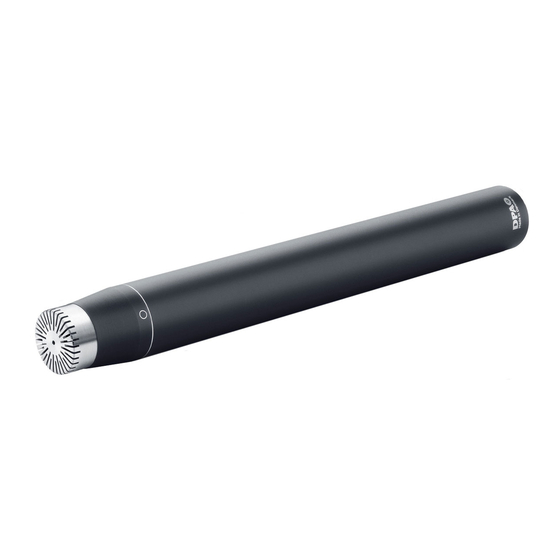- ページ 3
マイク DPA 3529-AのPDF ユーザーマニュアルをオンラインで閲覧またはダウンロードできます。DPA 3529-A 11 ページ。 Omnidirectional microphones
DPA 3529-A にも: ユーザーマニュアル (13 ページ)

The Near-field Grid
The Near-field Grid DD0251 on the microphone cartridge is
designed to have a linear on-axis frequency response for near-field
applications (see Fig. 3 for frequency responses measured with the
Near-field Grid). The grid is factory mounted but can be exchanged
with the DD0297 Diffuse-field Grid or the UA0777 Nose Cone.
Please be extremely careful not to touch the exposed diaphragm
when changing the grids.
The Diffuse-field Grid
The Diffuse-field Grid DD0297 is supplied as standard. It is
designed for diffuse-field recordings, or recordings in the far field.
The grid gives a high-frequency boost on-axis of 6dB around 15kHz
(see Fig. 4) without adding noise to the recording. This boost gives
a linear diffuse-field (far field) response up to 15kHz.
The Nose Cone
The Nose Cone UA0777 is available as an optional accessory . As
with the Diffuse-field Grid DD0297, the Nose Cone is simply
screwed onto the microphone cartridge in place of the Nearfield
Grid DD0251. When fitted, the Nose Cone gives the microphone a
true omnidirectional response even at high frequencies (see Fig. 7)
and a linear diffuse-field response (see Fig. 5). These qualities are
useful at any distance for an even tonal balance of sound arriving
at all angles of incidence, e.g. room reverberation or several sound
sources placed around the microphone. The diaphragm is placed in
a slot behind the solid cone and sound waves only have access to
the diaphragm through the side of the Nose Cone. This way the
Nose Cone prevents an on-axis, high frequency sound pressure
build-up on the microphone, which is the reason for normal flat
fronted omnidirectional microphones becoming more and more
directional for higher frequencies. There is, however, a slight high
frequency boost on axis.
4
Acoustic Pressure Equalizers
Available as optional acoustical attachments are also the APEs –
Acoustic Pressure Equalizers. The APEs use diffraction to passively
modify the sound field near the microphone diaphragm, thus
changing the microphone's frequency response and, in particular,
the polar response (see Fig. 11 and Fig. 12) without adding any elec-
trical noise to the recording. The size and shape of the APE deter-
mines the acoustical changes of the microphone. The APEs are pre-
cision made from a special compact nylon material and will only fit
the Types 4003 and 4006 fitted with the standard Nearfield Grid
DD0251. There are four different APEs in the range: L30B is a
Ø30mm ball-shaped APE marked with a blue dot, L40B is a Ø40mm
ball-shaped APE marked with a green dot, L50B is a Ø50mm ball-
shaped APE marked with a red dot and the L110C is a cylinder-
shaped APE, 110mm long and marked with a yellow dot. The APEs
can be obtained as single units or in two different equalizer kits:
APE L4 contains 4 different APEs and APE L8 contains 2x4 differ-
ent APEs. See Fig. 14 for how to mount the APEs on the micro-
phone.
The Passive Connection Converter
The PCC4000 Passive Connection Converter is an optional accesso-
ry that makes it possible to run High-Voltage Microphones on stan-
dard 48V phantom power with reduced microphone specs. The
maximum reduction of the microphone SPL handling capability will
be 13dB and it is possible to drive up to 100m of cable with the
PCC4000 with the same specifications. Like the High-Voltage
Microphones the PCC4000 is transformerless. The input connector
is a modified 4-pin female XLR for connection directly to the micro-
phone. The output is a standard 3-pin male XLR-connector for con-
nection to standard cables.
5
